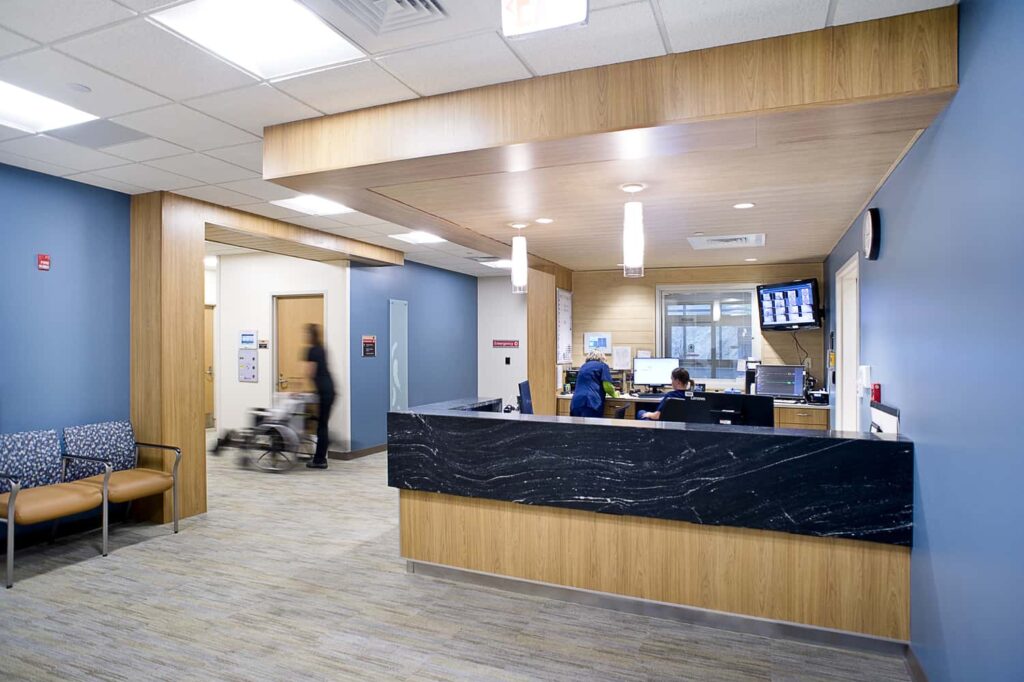Stakeholders across the healthcare industry are thinking about site-of-care shifts. Which services are likely to look completely different in the not-so-distant future? What are the driving forces and indicators? And how can healthcare providers and organizations prepare for clinical services to move away from the hospital and into settings like ambulatory surgery centers (ASCs) to meet the demands of the evolving outpatient landscape?
This is our bold new reality, as described by the Advisory Board’s Megan Director. With a patient journey that can more often leave the hospital out of the picture for everything but acute care, the Advisory Board forecasted a nearly 3% decrease in five-year inpatient growth projection, and an almost 13% increase in outpatient growth forecast for 2020-2025.
Now is the time to reimagine care delivery outside the walls of a hospital, and to proactively adjust strategic, operational, and financial plans to seize the opportunities presented by the “next normal.”
The Ambulatory Care Landscape in 2021
According to Director, “The fact is more services are being provided that do not require the overnight stay and acute care of a hospital.” We’re at the intersection of regulatory and payer pressure — all of which have only been compounded by the pandemic — resulting in the desire among payers, patients, and providers to avoid the hospital at all costs.
Patients and providers are getting more comfortable with non-hospital settings, and the obvious benefits don’t hurt. Along with lowered risk for contracting COVID-19 and other diseases, lower copays and increased access are attractive for patients. Physicians see the business opportunities of freestanding sites of care and are adjusting their planned capital expenditures accordingly. Furthermore, hospitals benefit from having higher capacity for those truly higher-acuity procedures that are best performed on-site.
Four Site-of-Care Shifts to Watch Now
1. Diagnostics and non-invasive services are moving off-campus.
There is a sense that many programs for low-acuity diagnostic services have “gotten a bit too comfortable on campus,” according to Director. This is due to the higher reimbursement rates and the logistical convenience of managing most patients and services at one site. However, from the patient experience standpoint, the hospital setting comes with higher copays, longer wait times, and inconveniences like transport and parking. Providers are trying to identify services that can take place off-campus where appropriate.
Then there’s the small matter of reimbursement. Per CMS’s site-neutral payment policy, which Director describes as “a thorn in the side of many health systems,” she says, “If a hospital has an HOPD or hospital outpatient department that is further than 250 yards from the hospital building, and it was built or acquired after November 1 of 2015, then they will only be paid 40% of the traditional hospital outpatient payment rate.”
Purchasers are also steering way from higher-cost providers. For health plans, this could mean denied authorizations for on-campus imaging services like CT and MRI that could have safely taken place elsewhere.
Further, there’s the looming presence of intense competitors who are keen on owning more of the healthcare continuum, including some purveyors of what Director calls “ultimate convenience,” or primary care that offers minimal copays but maximum accessibility.
Innovative retail clinics like Walmart, CVS, and Amazon are not just setting patient expectations for convenient, non-hospital care. They’re also expanding their services like chronic care management to directly compete with hospital business.
Director says hospitals and health systems should position themselves to be “meeting and matching” these competitors, particularly freestanding care locations. And they should think about the pricing and accessibility of diagnostic services from the standpoint of patients-turned-consumers who are increasingly price shopping to find the best deal.
2. Procedures are shifting to ASCs and office-based labs.
For physicians, ASCs are an increasingly attractive prospect due to ownership opportunities, payer incentives, and higher throughput and patient volume resulting from higher operational efficiency.
For patients, ASCs offer significantly lower copays and out-of-pocket responsibility for the same procedure, along with convenient access and parking, appointment availability and ease of scheduling, minimal wait time, and less risk than the hospital setting of exposure to COVID-19.
There are two service lines in particular that are seeing a lot of activity and interest from an ASC standpoint. Because CMS has approved total hip and knee replacement in an ASC, freestanding orthopedic settings stand to capture more of the market. With the 2019 CMS approval of diagnostic cardio-vascular caths, patient and provider demand for these lower-cost facilities is ramping up.
3. Home-based delivery of acute and post-acute care is on the rise.
While the stay-at-home trend for both acute and post-acute care was well underway pre-COVID, the pandemic certainly added fuel to the fire. There is now a long list of services spanning the care continuum that have the potential to shift to the home. However, there are a range of practical and regulatory constraints that we must contend with — especially for those receiving home-based senior care — including clinical limitations like multiple comorbidities requiring high-licensure staff. There are personal and environmental challenges that make home care infeasible for some, and there’s still a lack of reimbursement, especially for some services that go beyond acute provider care into long-term care management.
4. Outpatient care is being delivered virtually.
One bright spot of the pandemic was how quickly policymakers moved and the healthcare ecosystem responded to give more patients access to care via telehealth. The technology has value far beyond primary care visits, such as provider-to-provider consultations, training, or a specialist paying a virtual visit t in a rural or underserved area.
Director urges health systems to start asking themselves how telehealth might help solve problems, how it could support the larger strategic aims as a business, and to explore how it can be used to support many different service lines and system goals. For instance, telehealth can protect and reserve hospital capacity for truly acute services, or to expand patient access to improve care management across the continuum and reduce the total cost of care.
Additionally, Director invites us to ask and answer some hard but necessary questions: “Are we democratizing access bringing care closer to marginalized communities? Are we advancing equity through these services? In fact, our fear is that if we’re not careful, it may do just the opposite.” For those without broadband access, for example, adopting telehealth is a major challenge. So, Director encourages the entire ecosystem to think proactively about how to bridge the digital divide.
Where Imagination Meets Rigor: Tips for Future-Proofing Your Strategy
Even though the ambulatory space is growing overall, some types of facilities have a more positive outlook than others. Naturally, providers are trying to determine the most appropriate use of sites like micro hospitals and freestanding emergency departments. The key is to think a few years ahead — through the nuanced lens of your specific market — about the implications of these trends and their impact on current investments. Here are some of Director’s top recommendations:
- Make outpatient payment and regulatory policy an ongoing focus.
- Beyond merely staying educated, conduct opportunity analyses and scenario planning exercises, tune into what matters to commercial plans, and anticipate their mechanisms to take advantage of lower-cost sites.
- Benchmark your facilities and market to understand your position compared to others in your state and nationally. Look at whether your investments align with forecasted demand.
- Evaluate the competitiveness of your ambulatory footprint and your virtual readiness. What are your competitors doing in this space? Are there new market entrants? How do you meet the virtual demands of your consumers?
- Ask yourself: If an ASC opened down the road today and started doing procedures, how would we compete? What would our message be to patients and referring physicians? How do we make sure that we are always staying one step ahead of the market?
With these tools, questions, and considerations in hand, healthcare providers and designers can proactively work together to reimagine care delivery outside of hospitals, and, ideally, better serve the people in each community and population.
David Voller, MBA, former senior operational planner, is an experienced facilitator and operations leader with a demonstrated history of producing revenue, reducing operating costs, implementing new systems, developing strategic goals, and building cultures for change through redesigning operations. Prior to BWBR, David had more than 20 years of work at hospitals and health systems, including Mayo Clinic and Gillette Children’s Specialty Healthcare.








